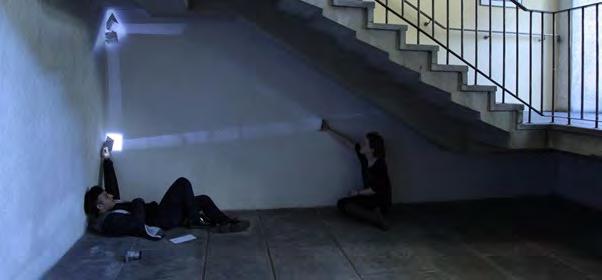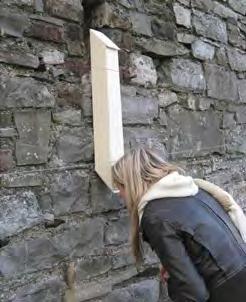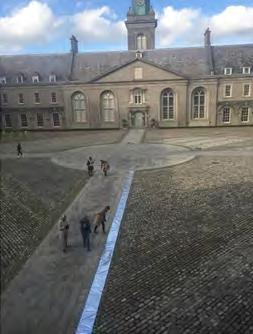
7 minute read
groundwork: the art museum as a site for research
from Museum Ireland, Vol. 27. Widdis, B. (Ed.). Irish Museums Association, Dublin (2021)
by irishmuseums
MUSEUM IRELAND 2020
groundwork: the art museum as a site for research
Advertisement
Lisa Moran
Introduction
In this paper, I discuss the ways in which research takes place in the Irish Museum of Modern Art (IMMA) and how a new strand of programming, groundwork, 1 aims to make existing and new modes of research visible.
1st year IADT students developing their research project in the basement of the Irish Museum of Modern Art, 2013.
Credit: IMMA/IADT Research is a reflexive process involving experimentation, problem-solving and risk, and as such, happens constantly in art museums. It is concerned with discovering new information or reaching a new understanding. There are many definitions of research, including ‘a studious inquiry or examination … aimed at the discovery and interpretation of facts … the collecting of information’.2 Also, ‘the detailed study of a subject, especially in order to discover (new) information or reach a (new) understanding.’3 Common to all research, though, is the aim to make known something that was previously unknown.

IADT student project installed in the Irish Museum of Modern Art, 2016.
Credit: IMMA/IADT
Delivered through a series of case studies, the title and methods of groundwork refer to and conceive the practice of research as something that happens on the ground, in the field, and by being present, observing, gathering, reflecting and analysing. The first groundwork case study to be discussed here is The Place Project, 4 an innovative research project involving over 400 students that has taken place in IMMA over a ten-year period, leading to new understandings and harnessing new knowledge. The modes of research The Place Project has used draw on its early associations, as suggested by the Old French recerchier, to ‘seek out, search closely,’ and the Latin circare, to ‘go about, wander, traverse’.5
Research in an art museum
Research is central to the work of artists, both in the conception and realisation of their work, and in how that it is communicated to a wider public through exhibitions that capture and articulate the new knowledge it produces. Exhibition curators also undertake research, including through the development and implementation of exhibitions. This research may encompass the lives and work of artists featured, exhibition themes or subjects, the materials and methodologies artists employ, and the context of the art works. It informs how curators structure exhibitions, what they focus on and how they communicate the artwork to audiences and other users.
As a museum of modern art concerned with contemporary experience, IMMA’s subject exists and reveals its meaning in the present. Some of the work that is exhibited in IMMA did not exist prior to its exhibition and, in some cases, came about in the realisation of exhibitions or was the result of IMMA commissions that were informed by research. Collection curators undertake and commission research into the artworks in the collections - and research into the artists that create them - and research is also involved in IMMA’s practices of data management, archiving and conservation.
Research is central to the work of IMMA’s engagement and learning curators, informing public programming and underpinning the development of strategies to engage people with contemporary art. The museum’s technical crew undertakes research into artists’ materials and methodologies and into the new technologies that inform the installation of the art works. Members of the visitor engagement team research the artists and artworks featured in the exhibitions and represented in the collection, and in the preparation of their guided tours, workshops and public programmes. IMMA’s Artists Residency Programme provides artists with an opportunity to undertake research in the development of their practice. This is not to suggest that everything that happens in an art museum is research, but to point to the fact that many people working in an art museum are involved in research in the day-today implementation of their work.
IMMA as a site for research
As a site for research, IMMA is located in a significant building that provides a rich historical context and counterpoint to its contemporary focus. In addition, IMMA - as a whole - has a wealth of knowledge and resources across its programmes, staff and archives that constitutes the raw material of research. While the core functions of the museum are housed in the main
building, there are also a number of peripheral buildings that provide collection storage, artists’ studios and workshop and discussion spaces. The museum is also situated within a substantial urban green site that provides a campus for hosting innovative and experimental research initiatives such as The Place Project.
The Place Project
The Place Project is a reflection on a unique longterm collaboration between IMMA and the Institute of Art, Design and Technology (IADT) BA Art programme. What started off as a one-off site visit, has grown into an ongoing, museumbased student research programme that has informed how IMMA engages with third-level students. The IADT course module began as a sitespecific project focusing on IMMA as the place. It is intended to develop the students’ research skills in the development and implementation of their research projects in response to IMMA and its grounds. The term ‘place’ offers latitude for students to approach IMMA in many ways: as museum, gallery, institution, public space, historical site, architectural structure, environment, destination or cartographical point.
Over ten years, The Place Project has developed into a comprehensive, self-directed student research project, incorporating peer and professionalled learning, professional mentoring and public presentations of active research on site. The students engage with IMMA staff in various roles, including curators, the visitor engagement and security teams, technical crew, OPW gardeners, resident artists, and the museum’s visiting public.
In January of each year, approximately 40 students arrive on site at IMMA. Students are based in IMMA’s workshop studios for the twelve weeks of the research project, which provides a base out of which the students conduct their research. Following an introduction to the museum, its programmes, staff and site, they explore the galleries, courtyard, café, great hall, chapel, artists’ residency studios, and the museum’s environs: the gardens, graveyards, meadows and woodland. They become familiar with its structure, content, spaces, people, rules, constraints and possibilities, all of which inform their unique research projects. For the tutors, art research is the practice of being lost in ‘thinking through making’; to wander - as the students do - is not aimless but is dynamic, a skilled intuitive response to what is discovered in the process. Through their explorations of the Museum’s buildings and grounds, by meeting staff and artists and by encountering the public, students develop their research ideas, reflecting their own interest, curiosity, and particular observations. Over the course of the twelve weeks, they can be seen in various sites around the museum and grounds, drawing, filming, measuring, observing, photographing, performing, interviewing, taking samples or just sitting chatting. Visitors to the museum therefore encounter students activating the museum as a dynamic and live space for research.
At the end of the twelve-week module, students present the outcomes of their research projects to each other, to museum and IADT staff, and to the visiting public. These outcomes can take many
IADT student project installed in the Irish Museum of Modern Art, 2016.
Credit: IMMA/IADT

forms, ranging from displays of research material, ideas and art works to performances, temporary interventions and happenings in the studio spaces or on site in the buildings and grounds of IMMA. Family and friends join the students to see the results of their research projects and to celebrate the end of the project. It is a moment of great pride for the students in the presentation of their research in response to, and in the context of, the museum.
Conclusion
The Place Project is an open-ended, exploratory and mutually beneficial collaboration between a third-level education institution and a museum of modern art, centred on the experiences of students in the formative stages of their careers as artists and researchers. It enables IADT to explore the possibilities of developing an ‘onlocation’ teaching environment and it enables IMMA as a museum to explore ways in which it can be activated as a site of research and learning. This is, then, a process of constantly and mutually redefining what both ‘museum’ and ‘education’ might mean.
The long-standing relationships and commitment to The Place Project by IMMA and IADT, has enabled multiple conversations, resourcefulness and trust to build over ten years. This has helped both institutions to cultivate what has now become a unique model of collaboration between an art museum and a third-level education institution. The BA Art programme at IADT has been enhanced through The Place Project, enabling first-year art students to understand how the museum and its resources can be a foundation for research and a model of off-campus, museum-based learning. Reciprocally, some of the learning outcomes of The Place Project have informed the way in which IMMA understands its role as a site for research and has transformed how it engages with other student groups.
Dr Lisa Moran is Curator: Engagement and Learning at the Irish Museum of Modern Art.
imma-groundwork/.
2. ‘Research’, Merriam-Webster, https://www.merriam-
webster.com/dictionary/research.
3. ‘Research’, Cambridge Dictionary, https://dictionary.
cambridge.org/dictionary/english/research.
4. ‘The Place Project Exhibition’, Base 1 Art, https://
base1artiadt.wordpress.com/place-project-exhibition/.
5. ‘Research’, Online Etymology Dictionary, https://www.
etymonline.com/word/research#etymonline_v_12882.









